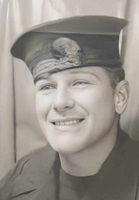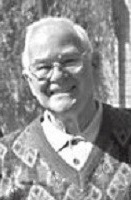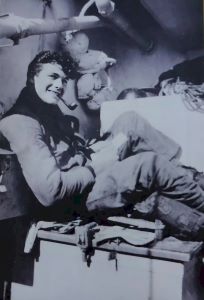|
In memory of those who have Crossed the Bar
BAMFORD, John Carmichael - was born in 1923 in Victoria and passed away peacefully on July 5th in his 86th year after a lengthy struggle with cancer. John will be deeply missed by his family and friends. John is survived by his loving wife of 59 years Verne, (nee Russell); his children, Linda (Tony), Mike (Lezlee), Harvey and Wendy; his brother, Gordon; his grandchildren Blair (Vanessa), Antonia (Scott), Teneel (Aaron), Bree-Anne and Karlee; and his great-grandson, Christian. He enlisted in the Navy in 1941 and served until the end of World War II, mainly on HMCS Sioux. John met the love of his life, Verne Russell, soon after the war and they were married in 1949. A large part of his working life was spent as a driver with Vancouver Island Coach Lines. His natural leadership and caring, responsible nature allowed him to make friends easily and forge lasting relationships. His children, grandchildren, relatives and friends all benefited from his wisdom, intelligence and integrity. Above all he enjoyed his family, taking pride in their many achievements. He was an excellent father and a loving, playful grandfather and great grandfather. A memorial will be held on Friday, July 10th, 2009 at 2 pm at First Memorial Funeral Services at 4725 Falaise Dr., Royal Oak. John's family extends its gratitude to the caring staff at Royal Jubilee Hospital, Richmond Pavillion. In lieu of flowers, donations may be made to the Canadian Cancer Society.
Submitted by John's son Harvey Bamford: During his first years in the navy he was involved in the Atlantic crossings ( 20 plus times ) back and forth in 41, 42, 43 until he was assigned to the HMCS Sioux in1944. He was an anti Aircraft gunner on board the Sioux operating a Oerliken 20 mm cannon on the port side. My father was on board SIOUX for the Normandy Landings.
My father told us that he actually shot down a German plane that was low level / surface level strafing the ships that were positioned off the coast ( Juno Beach ) and assigned to protect the HMS Rodney that was performing inland bombing and creating havoc for the Germans. He told us on June 10th the German Luftwaffe was once again trying to knock out the Rodney and any other ships. He explained their flight and attack Tactic was to fly overhead and high up and pass over high above the ships and then drop down from behind, and come at the ships low to the ocean surface and strafe the ships in that manner while specifically aiming for HMS Rodney. They were doing this just as dawn was breaking and half dark and half light and also during the evening just as it was half dark and half light before sunset. They could hear the Aircraft passing above and hear them dropping down and coming at them from the ocean side.
At his AA gun position was on the port side he could hear the plane. He saw to his left and leveled his gun, leading the plane and started firing along with other gunners while performing a fast left to right sweeping motion taking care to stop shooting before they other ships came into his line of fie. So, in effect, only 4 to 5 to 6 seconds of time to fire relative to first starting to fire upon the Aircraft to his left and when he would have to stop firing or be firing upon the accompanying ships nearby.
He fired along with others also firing and within 3 to 4 seconds the aircrafts engine was being torn apart by hits and burst into flames with the plane passing by close enough that my father could see the flames engulfing the cockpit and the pilot that was panicking and trying to open the cockpit canopy and bail out but to no avail as the plane quickly nose dived into the water in front of SIOUX off the Starboard side.
The ships observers starting telling my father that it was his tracer bullets seen cutting in front of the engine and then bullets striking the engine and crippling the aircraft. He told us he was not sure if it was his bullets that hit the plane but the observers insisted the tracers seen crossing just in front of the aircraft were from his gun and he credited my father with the hit. He told us he was reluctant to take credit for the hit as other gunners from his ship and the ship across from him had also being firing upon the same aircraft.
He said he was not feeling glorious at all rather he could not stop thinking about the German Pilot and how he could clearly see the pilot passing by and panicking and trying to bail out and died in front of him while his ship mates were congratulating him and plenty of congratulatory slaps on the shoulders and back and rubbing his hair and head. He felt it was a combination of good luck and skill as he started firing while sweeping his gun from left to right about as fast the the cannon swing mechanism would allow while firing at the plane estimated to be passing by at around 250 plus miles per hour.
He told us that he always maintained his gun in top working order and made up his own grease based lubricant mixed with graphite and liberally applied to all the working mechanisms on the cannon configuration for smooth movement. He told us that he would site in on seagulls that were flying above and hovering close by as seagulls do and follow the seagulls in his gun sights while operating the mechanics and practicing - always practicing aiming at something.
He explained to us that he figured those gun maintenance factors and the timing at which he started to fire his gun and his practice skills all came together resulting in a kill occurring in a very short 4 to 5 seconds of firing upon the enemy aircraft.
Ships served in:
(JB01) Portrait of Seaman John Bamford (JB02) John Bamford on unknown ship - possibly SIOUX
|




